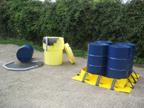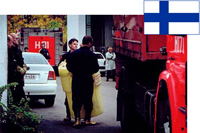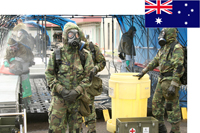- SPCC - Spill Prevention , Control and Countermeasure Act
- 49 CFR 173.3 - Salvage Drums
- 40 CFR 264.173 - Management of Containers
- 40 CFR 264.175 - Containment of Containers Containing Free Liquid
- EPA 40 CFR 264.177 and EPA 40 CFR 265.177 - Special Containment Requirements for Incompatible Wastes
- EPA 40 CFR 264.1086 and EPA 40 CFR 265.1087 - Closed Container
- New York State Chemical Bulk Storage Regulation
- Basic Requirements of a SWPPP (Storm Water Pollution Prevention Plan)
- 29 CFR 1910 - Wiring Design and Protection (Sidewinder)
Spill Prevention, Control and Countermeasure Act
Intent
Driven by the EPA's Federal Water Pollution Control Act (as amended by the Clean Water Act), this ruling is designed to prevent discharges of oil and oil-related materials from reaching navigable waters and adjoining shorelines.
Background of the SPCC Act
The SPCC rule took effect on January 10, 1974. It was revised and strengthened in July of 2002. Parts of the original rule were unclear (i.e. container size was not specified) and compliance was expensive for small business due to the need to obtain certification by a Professional Engineer (PE).
Regulated Materials
Animal oils, fats and greases (including oils from fish or marine mammals), asphalt, aviation gasoline, bunker fuel, crude oil, cutting oil/machine coolants, dielectric fluid, diesel fuel, heating oil, gasoline, greases, hydraulic oil, jet fuel, lubricating oil, mineral spirits, motor oil, naptha, natural gas condensate, oil refuse, oily wastes (other than oil mixed with dredged soil), stoddard solvent, synthetic oils, tall oil, turpentine, residual fuels, used oil, vegetable oils (including oils from nuts, seeds, fruits and kernels). These materials are hereafter referred to as “oil” in this document.
Who must comply?
Facilities with total, above-ground, oil storage capacity (not actual gallons on site) of greater than 1,320 gallons. Storage containers that are 55-gallons and greater are used to calculate total capacity. Facilities with below-ground storage capacity of greater than 42,000 gallons must also comply. Facilities that meet such criteria must develop and implement a written SPCC Plan. Certain facility types, i.e., convenience stores, are exempt. In addition, EPA has extended compliance dates for four (4) problem areas: a) qualified, oil-filled operational equipment, b) motive power containers, c) mobile refuelers, and d) animal fats & vegetable oils at onshore & offshore oil production, drilling facilities.
What are the basics of an SPCC Plan?
The SPCC Plan must address all relevant spill prevention, control and countermeasures necessary to minimize the potential for oil discharge. One requirement is to provide appropriate containment and/or diversionary structures, i.e. dikes, berms or retaining walls, to prevent a discharge. A means of secondary containment sufficient to contain the capacity of the largest single compartment or container is mandated. Products that seal drains or divert spills from drains, as well as sorbents, are considered "control" or "countermeasures".
When is compliance required?
Compliance dates for facilities (other than farms) are as follows:
|
A FACILITY STARTING OPERATION... |
|
MUST…….. |
|
On or before August 16, 2002 |
 |
Maintain its existing Plan; must amend and implement the Plan no later than July 1, 2009. Facilities in this group that do currently have an SPCC Plan are out of compliance and are subject to regulatory action.
|
| After August 16, 2002 through July 1, 2009 |
Prepare and implement a Plan no later than July 1, 2009.
|
|
|
After July 1, 2009 |
Prepare and implement a Plan before beginning operations.
|
How do I comply?
Visit http://www.epa.gov/oilspill/spcc.htm to review the SPCC Regulation in its entirely.
DOT 49 CFR 173.3(c) Salvage Drums. Packages of hazardous materials that are damaged, defective, or found leaking and hazardous materials that have spilled or leaked (including used sorbents) may be placed into a metal or plastic removable head drum that is compatible with the lading and shipped for repackaging or disposal under the following conditions:
- Drums must be a UN 1A2, 1B2, 1N2 or 1II2 tested and marked for Packing Group III or higher performance standards for liquids or solids and meet a leakproof test of 3 psi.
- Each drum shall be provided when necessary with sufficient cushioning and absorption material to prevent excessive movement of the damaged package and eliminate the presence of any free liquid at the time the salvage drum is closed.
- Each drum shall be marked with the proper shipping name of the material inside the packaging and the name and address of the consignee. In addition, the drum shall be marked “Salvage Drum.” (Note: an “Overpack” is not a Salvage Drum, unless it meets the requirements of 1, above.)
- Each drum shall be labeled as prescribed for the respective material.
- The shipper shall prepare shipping papers in accordance with subpart C of Part 172.
EPA 40 CFR 264.173 (1995) Management of Containers. A container holding hazardous waste must always be closed during storage, except when it is necessary to add or remove waste. A container holding hazardous waste must not be opened, handled, or stored in a manner which may rupture the container or cause it to leak.
EPA 40 CFR 264.175 Containment of Containers Containing Free Liquid. A containment system must be designed and operated as follows:
- The containment unit must underlie the containers and must be free of cracks or gaps and be sufficiently impervious to contain leaks, spills and accumulated precipitation.
- The base of the containment unit must be sloped or designed to drain and remove liquids resulting from leaks, spills or precipitation, unless the containers are elevated or otherwise protected from contact with accumulated liquids.
- The containment system must have sufficient capacity to contain 10% of the volume of containers or the volume of the largest container, whichever is greater.
EPA 40 CFR 264.177 and EPA 40 CFR 265.177 Special Containment Requirements for Incompatible Wastes. A storage container that is holding a hazardous waste that is incompatible with any waste or other materials stored nearby in other containers, piles, open tanks, or surface impoundments must be separated from the other materials or protected from them by means of a dike, berm or other containment device.
EPA 40 CFR 264.1086 and EPA 40 CFR 265.1087 Closed Container Regulations (Federal Register 12/6/94) Containers which store hazardous waste must have a cover which operates with no detectable organic emissions when all container openings, (e.g., lids, bungs, hatches, etc.) are secured in a closed, sealed position.
Each container opening shall be maintained in a closed, sealed position at all times that hazardous waste is in the container except when it is necessary to use the opening to:
- Add, remove, inspect, or sample the material in the container;
- Inspect, maintain, repair, or replace equipment located inside the container, or
- Vent gases or vapors from a cover located over or enclosing an open container…
- Safety devices that vent directly to the atmosphere may be used on the devices meeting all of the following conditions:
- The safety device is not used for planned or routine venting of organic vapors from the container...
- The safety device remains in a closed, sealed position at all times.
New York State Chemical Bulk Storage Regulation Section 599.17C - Secondary Containment for Transfer Stations.
(c) Secondary containment for transfers. (1) Transfer of hazardous substances must take place within a transfer station which is equipped with a permanently installed secondary containment system.
(2) This containment system must:
(i) be capable of collecting leaks and spills which are likely to occur during the transfer including leaks or spills from connections, couplings, vents, pumps and valves, hose failure or overturning of a container. Open-ended fill lines must be located with the secondary containment system;
(ii) be designed and constructed with a permeability rate to the substance(s) transferred of less than 1 x 10-6 cm/sec. Properly designed concrete which has water stops on all seams and is compatible with the substance(s) stored or other equivalent or superior material satisfies this requirement;
(iii) be designed, installed, and operated to prevent any migration of hazardous substances, components of hazardous substances or degraded products, out of the system to the soil, groundwater, or surface waters before cleanup occurs. The system does not have to be designed to contain the gaseous component of a spill;
(iv) be constructed, coated, or lined with materials that are compatible with the substances to be transferred and the environment. The system must have sufficient strength and thickness to withstand wear, hydrostatic forces, frost heaving and weathering. It must support without failure, any vehicle brought into the transfer station, and must have a foundation which prevents failure due to settlement, compression, or uplift;
(v) be equipped with a sump and either a manually controlled pump or siphon, manually controlled dike valve, or any other manually controlled drainage system to permit the drainage of liquids resulting from leaks, spills, and precipitation. Control of the pump, siphon or valve must be possible from outside of the diked area. All drainage systems must be locked in a closed position when a transfer of a hazardous substance is in progress. Spilled or leaked substances must be removed from the containment system within twenty-four (24) hours; and
(vi) contain the volume of any leak or spill likely to occur at the transfer station.
(3) Stormwater must be pumped from slop tanks and catch tanks to allow for the containment of the volume required by subdivision 599.17(c)(2)(vi) above.
BASIC REQUIREMENTS OF A STORMWATER POLLUTION PREVENTION PLAN
| A Stormwater Pollution Prevention Plan (SWPPP) is basically an erosion, sediment and waste chemical control plan. It is up to the permit holder to decide what types of Best Management Practices (BMPs) to use at a given site, but the company/municipality/contractor must comply with the permit requirement. SWPPPs will typically include: |
|
| What are the Permit Requirements? Permit holders are required to develop, implement and enforce a stormwater management program to: |
|
What are baseline BMPs?  |
|
What are Advanced BMPs?  |
|
| Partial List of Industries Requiring a Stormwater Pollution Prevention Plan | |
|
|
All required tests shall be performed before first use; before equipment is returned to service following any repairs; before equipment is used after any incident which can be reasonably suspected to have caused damage (for example, when a cord set is run over); and at intervals not to exceed 3 months, except that cord sets and receptacles which are fixed and not exposed to damage shall be tested at intervals not exceeding 6 months
Flexible cords and cables shall be protected from accidental damage. Sharp corners and projections shall be avoided. Where passing through doorways or other pinch points, flexible cords and cables shall be provided with protection to avoid damage.



